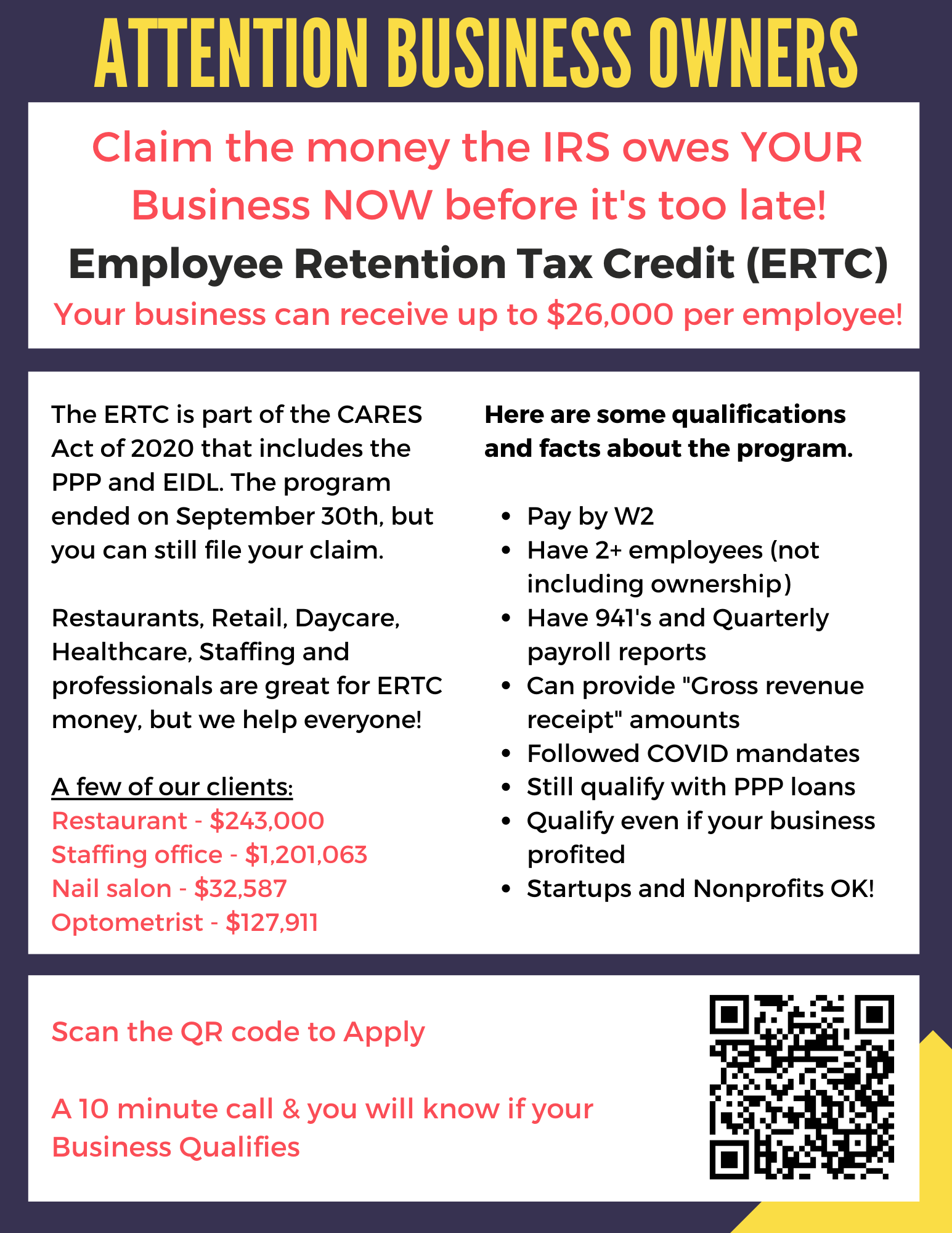In general, wages and compensation that are subject FICA taxes as also qualified health expenses are eligible for the employee retention credit. These must be paid after March 12, 2020. Credits are available if paid by Sept. 30, 2021. (Recovery Startup Businesses had up to Dec. 31,2021). Employers who meet the criteria, including PPP recipients can claim a credit up to 70% of qualified wages. The credit now applies to wages up to $10,000 per quarter. The American Rescue Plan extends the availability of paid leave credits for small and medium businesses that offer paid leave to employees in case of illness, quarantine or caregiving through September 2021.
Why is it important to apply for the employee retention tax credit?
The Employee Retention credit was introduced by Congress in the Coronavirus Aid, Relief and Economic Security Act. It was intended to encourage employers and employees to stay on the payroll during the coronavirus outbreak. However, the credit was limited to $10,000 per person and was only available for wages paid from March 13, 2020, through December 31, 2020. It has since been updated, increasing the percentage of qualified wages to 70% for 2021. The per-employee wages limit was increased from $10,000 to $10,000 per year to $10,000 each quarter. However, employers with less than 100 employees and employers with less than 500 employees are subject to different rules for certain periods of 2020 or 2021.
Additional requirements include that the employer has retained its employees and paid them at the minimum $600 in qualifying wage wages during the relevant period. Qualifying wage types include hourly or salary pay, commissions, and any other form of compensation. The employee retention credit can be used for wage payments that were made between March 13, 2020, and December 31, 2020. The credit is equal to 50% of the qualified wages paid by the employer to its employees. The maximum amount of qualified wages per employee is $10,000, so the maximum credit that an employer can receive is $5,000 per employee.
The Debate Over Employee Retention Credit
If you are looking to outsource Paychex can help you manage HR, payroll, benefits, and more from our industry leading all-in-one solution. Keep in mind that any eligible employer receiving these grants must keep records justifying where the funds were used. The funds can only be used for eligible purposes no later than March 11, 2023 in order to qualify for RRF. However, the SVOG dates can vary. If you are a new business, the IRS allows the use of gross receipts for the quarter in which you started business as a reference for any quarter which they do not have 2019 figures because you were not yet in business.
Who is eligible for the Employee Retention Credit?
Eligibility rules have been updated for 2021.To be considered for the credit, more than a nominal portion of the employer`s business operations must have been suspended. A portion is considered more then a nominal percentage of an employer’s business for the purposes if it has not received less than 10% in gross receipts or if that portion is used to perform service.
If the employer receives a tax credit that is greater than the employer`s share in social security tax, the excess amount is refunded and paid directly to the employer. You may also qualify if your employer has experienced a significant drop in gross receipts. Once you have determined your total eligible wages paid, multiply it by 50% and calculate the employee retention credits. For example, if a company has 10 eligible employees, and each employee receives $10,000 in qualifying wage wages during a quarter of the year, the employer would be entitled a credit up to $50,000 ($10,000 x10 employees, x 50%)
Faqs Employee Retention Credit Under Cares Act Internal Revenue Services
Show a significant decline in gross receipts during a calendar quarter in 2020. This requirement applies to all quarters that have gross receipts less than 50%. Employee Retention Credit FAQsGet answers to common employee retention credit questions on topics such as shareholder/related-party wages, PPP impacts and aggregation rules. The COVID-19 relief legislation includes the employee retention credit. This is an important part for small businesses.
They generally include the employer-employee pretax portion and not after-tax amounts. A trade or business that was fully or partially suspended or had to reduce business hours due to a government order. The credit applies only for the portion of the quarter the business is suspended, not the entire quarter. If the employer`s total Social Security or Medicare liability exceeds the credit`s credit amount, depending on if the credit was issued before June 30, 2021 and after, the employer will be reimbursed the excess.
Is It Possible To Convert The Erc Into Income If I Receive It?
The Employee Retention Credit, which is not a loan, is a refundable and above-the line payroll tax credit. The 2020 credit is computed at a rate of 50% of qualified wages paid, up to $10,000 per eligible employee for the year. Eligible Employers are those with less than 100 employees. Credit is available for all employees earning wages in 2020.
What is the Employee Retention Credit?
Introduced in the Coronavirus Aid, Relief and Economic Security Act, the Employee Retention credits was designed by Congress to encourage employers and employees to stay on the payroll during the coronavirus outbreak. It was initially worth 50% of qualified employee wage but was limited to $10,000 for each employee. A maximum credit of $5,000 is granted for wages paid between March 13, 2021 and December 31, 2021. It has since been updated, increasing the percentage of qualified wages to 70% for 2021. The per employee wage cap was increased from $10,000 per yea to $10,000 per quartal. However, certain sections of 2020 and 2021 will have different rules.
Employee Retention Credit Square Support Centre Us
A government order that causes a trade to be suspended or reduced in hours. The credit is valid only for the quarter that the business has been suspended, and not the entire quarter. Most businesses can claim the credit on wages up to Sept. 30, 2021. However, certain businesses have until Dec. 31, 2021 in order to pay qualified wages. Although the Employee Retention tax credit program has officially ended, it does not affect a business`s right to retroactively claim ERTC. Businesses have up three years from the program`s end to do a lookback and determine if wages received after March 12, 2020, through the end of this program are eligible.
Six Common Misconceptions About Employee Credit Eligibility
A small employer is one that employs 500 or less full-time employees for the 2021 ERCs. An employer with 100 full-time equivalent employees or less is considered a small employer for the 2020 ERC. The student loan interest deduct allows for a tax deduction of up to $2500 for interest payments on loans that are for higher education.
The Most Effective Reason You Ought Not Buy Employee Retention Credit Qualifications
If your facts and circumstances seem uncertain to support the ERC based on current guidance, there is no rush. You have three years to file amended payroll tax returns within the prescribed time limit. Eligible employers will report the total qualified wages and related health insurance costs for each quarter on the applicable period`s employment tax returns (generally Form 941, Employer’s Quarterly Federal Tax Return). Employers may include wages paid to full-time and part-time employees in the calculation for the ERC.
The employer is eligible if the gross revenues in the calendar quarter exceed 50 percent of that in 2019. However, they aren`t eligible employers if the gross receipts exceed 80 percent in the calendar quarter compared to that same calendar quarter in 2019. Even though the program ended on 2021, businesses still can claim the ERC. When you file your federal tax returns, you`ll claim this tax credit by filling out Form 941.
The IRS will generally take the minimum wage price and combine it with your eligible expenses. Many business owners may find it difficult to determine eligibility due to the changes in the tax laws surrounding the ERC.
Who Qualifies to Receive the Employee Retention Credit (ERC).
Businesses required to suspend some or all operations due to COVID-19 government restrictions or companies that lost 50% of their gross receipts from the same quarter of the previous year qualified for the ERC.
If you had more employees than 100, you may be eligible if you paid employee wages even though Covid-19 has stopped your normal business operations. But wages that were applied to your PPP loan forgiveness cannot be used for your ERTC. If you haven’t already applied for PPP loans forgiveness, you might want to consider non-payroll expenditures to that in order to maximize the wages you can use to claim your ERTC. This article provides valuable information about partial or total suspension of operations.
Related: https://home.treasury.gov/system/files/136/Employee-Retention-Tax-Credit.pdf

